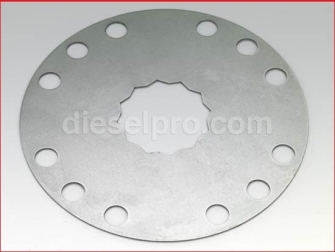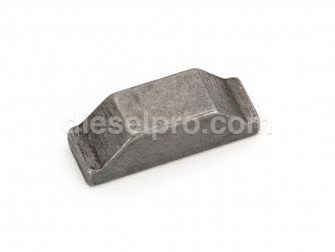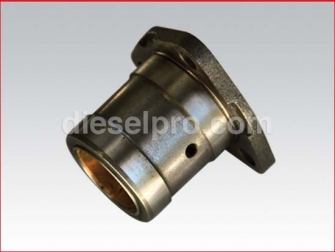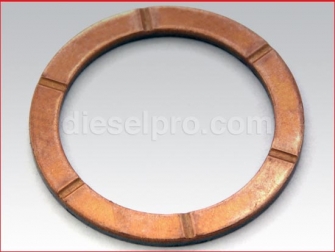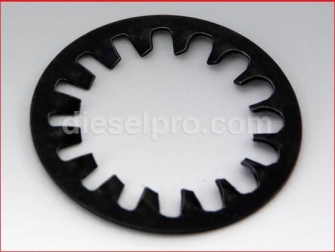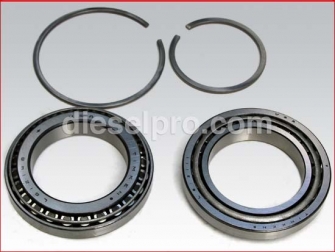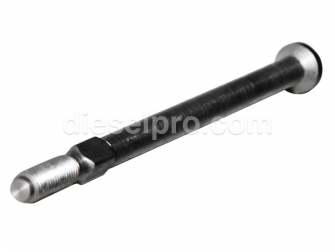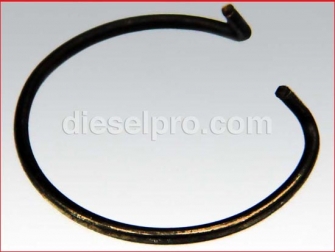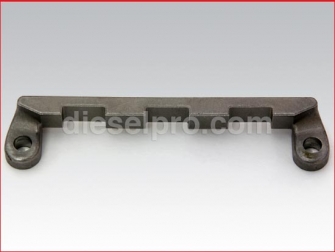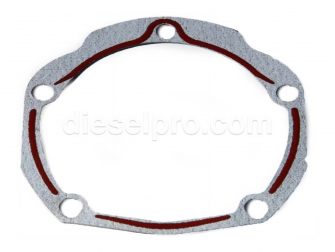Parts For Detroit Diesel 16V92 Turbo for Australia - Camshaft Section
 Loading...
Loading... Detroit Diesel 16V92 Turbo Camshaft & Related Component Catalog
Keep your Detroit Diesel 16V92 Turbo running crisp and on-time with a complete lineup of camshaft and valvetrain service parts. This catalog organizes every camshaft-related component in the same order you’ll find on the product page—so you can scroll, identify, and order exactly what you need without breaking stride. While several components are cross-compatible across Series 71 and 92 families, the guidance below is written specifically for the 16V92 Turbo platform and the realities of maintaining a high-output, turbocharged two-stroke V-engine in marine, industrial, and power-generation service.
Below you’ll find part-by-part explanations (what it does, common wear symptoms, and practical installation tips), followed by troubleshooting checklists, fitment notes, and maintenance best practices—all tailored to the 16V92 Turbo cam and gear train.
Camshaft Shell Set (Bearings) — Series 71/92
What it does
The camshaft shell set (often called “cam bearings,” metales or casquillos del árbol de levas) supports the camshaft in the block and maintains the precise oil-film clearance the 16V92 Turbo needs for stable valve event timing and quiet gear train operation. On the 16V92’s V-configuration, proper camshaft support prevents gear mesh irregularities that can otherwise ripple down to the blower, accessory drive, and timing gears.
When to replace
-
Audible gear whine or rhythmic knock that tracks with cam speed (half crank speed).
-
Low oil pressure localized to the cam gallery or unusual cam journal discoloration found during teardown.
-
Measurable out-of-round or excessive journal-to-bearing clearance during inspection.
-
Metal flake in oil analysis that correlates to bearing material.
Pro tips for installation
-
Clean, dry test-fit first, then oil every shell before final placement.
-
Align oil feed holes precisely; a misaligned shell starves the journal and accelerates wear.
-
Plastigage the installed clearance; verify within Detroit Diesel spec before final torque.
-
Pre-lube the cam journals and rotate by hand after torqueing caps to confirm smooth, drag-free rotation.
Camshaft Bearing Bolt (V71 & V92)
What it does
These specialty bolts clamp the bearing caps and maintain the precise alignment of the cam journals in a high-vibration environment. Turbocharged 16V92s impose higher cyclic loads; fresh, correct-grade bolts help keep caps from walking and preserve bearing geometry.
When to replace
-
Any time a bolt shows necking, corrosion, or damaged threads.
-
During full top-end or cam service—bolts are inexpensive insurance against future alignment drift.
Pro tips
-
Clean threads and use the correct lubricant or thread conditioner as specified for accurate clamp load.
-
Torque in sequence, then re-check after a short rest period to accommodate any embedment losses.
Cam Bearing Retaining Ring (Ring Lock)
What it does
The ring lock (aro retenedor) prevents the bearing shell from spinning in the housing bore under load. On a 16V92 Turbo, the combination of boost pressure and higher exhaust backpressure can transmit fluctuating loads to the camshaft; a positive lock is essential.
When to replace
-
If a ring shows loss of spring tension, burrs, or deformation.
-
Any time a bearing has shown signs of rotation or fretting in its bore.
Pro tips
-
Confirm groove cleanliness before seating. A tiny chip under the lock can prevent full engagement.
-
Verify end gap and seating with a mirror; the lock must be fully home around the entire circumference.
Camshaft Nut
What it does
The camshaft nut secures the cam gear to the camshaft snout, preserving precise phasing between crank, idler, and cam. On a performance-loaded 16V92 Turbo, correct clamp load here directly affects valve events and injector timing stability.
When to replace
-
If threads are nicked or if the nut has been removed and reinstalled multiple times.
-
Any observed rounding of flats or signs of galling.
Pro tips
-
Use a calibrated torque wrench and any specified locking compound.
-
Always pair with the correct retainer and lock components for redundancy.
Retainer for Camshaft Gear Nut
What it does
This retainer backs up the cam nut with a mechanical lock, protecting against loosening from torsional reversals. It’s a small part that saves engines.
When to replace
-
During any cam gear service. Retainers can fatigue from repeated bending or prior staking.
Pro tips
-
Follow the bend/lock procedure exactly; over-bending can crack the retainer and under-bending reduces security.
-
Inspect the cam gear face for prior tool marks and dress lightly if needed for flat seating.
Camshaft Woodruff Key
What it does
The Woodruff key (¼" × ¾") locks angular timing between the camshaft and cam gear hub. It transmits shear forces that align the gear during assembly and operation.
When to replace
-
Any time the gear has been removed.
-
Evidence of fretting or keyway peening in either the shaft or gear hub.
Pro tips
-
Test-fit key height; a key that sits proud can keep the hub from fully seating.
-
Match new key to a pristine keyway—de-burr before install.
Camshaft Seal
What it does
The camshaft seal (sello/retén del árbol de levas) prevents oil leakage at the cam drive end. On 16V92 Turbos, minor seal leaks can mist the front gearcase, attract grit, and accelerate gear wear.
When to replace
-
Anytime the seal lip is brittle, grooved, or weeping.
-
During scheduled cam or gearcase service as preventative maintenance.
Pro tips
-
Lightly oil the seal lip and cam snout.
-
Use a proper driver to keep the seal square; verify flush depth per spec.
Spacer — Front Camshaft Pulley (Series 71 & 92)
What it does
The spacer precisely positions the front cam pulley relative to the gear train and any accessory drives. Correct offset preserves belt/gear alignment and prevents axial thrusting.
When to replace
-
If there’s scoring, warping, or witness marks suggesting past misalignment.
-
Whenever the pulley shows tracking issues that aren’t due to bearings or belts.
Pro tips
-
Clean mating faces; even a thin gasket flake can skew alignment.
-
Verify runout with a dial indicator after assembly if you observed previous belt wander.
Camshaft Bearing (Front/Rear)
What it does
These are the dedicated front and rear support bearings (often called triángulos delantero y trasero in shop talk). In the 16V92 V-engine, the rear support takes significant torsional input from the drive train; both ends must be perfect to maintain gear lash and quiet mesh.
When to replace
-
Blueing, scoring, or measurable out-of-spec clearance.
-
Any history of low oil pressure events.
Pro tips
-
Measure housing bore and journal; don’t assume the new bearing alone cures noise.
-
Confirm oil feed path is open. After install, pre-lube and hand-spin to feel for any scratch or tight spot.
Front Camshaft Bearing (Dedicated Front)
What it does
This is the heavy-duty front bearing supporting the cam gear/pulley loads. On turbo models, higher dynamic forces from timing gear reversals make the front bearing’s integrity especially critical.
When to replace
-
If you hear persistent front gearcase whine that doesn’t change with accessory load.
-
Any sign of axial scoring or eccentric wear.
Pro tips
-
Check endplay against spec after bearing install and gear torquing.
-
Verify gear backlash with feelers or dial indicator where applicable; adjust shim packs as required.
Camshaft Bearing Washer
What it does
Acts as a hardened interface to evenly distribute clamp load and protect adjacent surfaces under torque.
When to replace
-
If the washer shows brinelling, dish-shaping, or corrosion.
-
Whenever you replace the mating bolt or nut.
Pro tips
-
Clean oil off the washer if the procedure calls for dry friction; follow spec for lubricated vs. dry torque.
-
Fit the correct side toward the fastener head if there’s a chamfer.
Camshaft Lockwasher (Series 71 & 92)
What it does
Provides mechanical insurance for critical cam fasteners, preventing back-off under vibration.
When to replace
-
After any removal. Lock features are single-use in most procedures.
-
If teeth or tabs are bent, cracked, or fatigued.
Pro tips
-
Engage a fresh tooth/tab and stake per the manual.
-
Don’t stack lock devices—use the one the procedure specifies.
Idler Gear Bearing
What it does
Supports the idler gear that transfers motion from crank to cam (and often to accessory drives). Smooth idler rotation is vital for quiet, accurate timing on a 16V92 Turbo.
When to replace
-
Rumbling or roughness when spun by hand.
-
Pitting/spalling seen under magnification.
-
Heat discoloration or metal found in the gearcase screen.
Pro tips
-
Press on the correct race only; never across rollers.
-
Verify shaft journal condition—replace the bolt/pivot if wear is present.
Idler Gear Bolt
What it does
Secures the idler gear to its pivot or carrier with the correct preload and shear strength. On V-engines, gear mesh forces are transmitted through these bolts continuously.
When to replace
-
During any idler rebuild, or when the bolt shows stretch, thread wear, or corrosion.
-
If prior torque history is unknown—fresh hardware prevents future movement.
Pro tips
-
Torque in stages and pattern where specified.
-
Use new washers/lock devices as required. Re-check backlash after tightening.
Pulley Drive Shaft Seal (71 & 92)
What it does
Seals the pulley drive shaft to keep the gearcase oil clean and inside—especially important on turbo models where crankcase vapors and external spray can deposit grit.
When to replace
-
Any evidence of weeping or oil sling around the pulley area.
-
During front-end service as preventative maintenance.
Pro tips
-
Inspect the shaft surface; polish a groove lightly or use a repair sleeve if required.
-
Light oil on the lip; install squarely to the housing.
Push Rod for Cam Follower
What it does
Transfers motion from the cam follower up to the rocker or injector linkage, converting the cam lobe profile into precise actuation. Straightness and tip integrity are everything.
When to replace
-
Bent rod found by rolling on a flat plate.
-
Mushroomed tips, pitting, or excessive wear.
-
Audible tick that persists after lash adjustment, traced to follower train.
Pro tips
-
Keep rods in order during teardown; reinstall to their original bores if reusing.
-
Verify free oil flow through hollow designs (where applicable) before install.
Push Rod Retainer
What it does
Holds the push rod in alignment relative to the follower, preventing side-loading and tip scuffing.
When to replace
-
Broken spring tabs, deformation, or loss of tension.
-
Any time push rods have shown signs of sideways rub.
Pro tips
-
Confirm retainer seating depth and that no clip interferes with follower travel.
-
Replace as a set on the affected bank to normalize tension.
Cam Follower Guide (Series 53, 71 & 92)
What it does
The guide keeps the cam follower (“camfollower”) precisely oriented over the cam lobe, preventing rotation and maintaining correct contact geometry.
When to replace
-
If guide bores are scuffed or out of round.
-
Follower shows angled wear or tracking marks off-center on the lobe.
Pro tips
-
Inspect follower roller or foot concurrently; replace in pairs (guide + follower) when wear patterns suggest misalignment.
-
Verify smooth follower travel by hand before buttoning up covers.
Flywheel Housing Gasket (V71 & V92)
What it does
Seals the interface between the end plate and flywheel housing, keeping the cam/gearcase compartment tight and free from oil mist leakage that can draw dirt.
When to replace
-
Any time the housing is removed or shifted.
-
Evidence of seepage at the joint line.
Pro tips
-
Scrape old material carefully; avoid scoring aluminum surfaces.
-
Use a light, even bead of the approved sealant only where specified.
Cam Follower Assembly
What it does
Converts cam lobe lift into linear motion for valve and injector actuation. On a 16V92 Turbo, healthy followers protect the cam from high-load scuffing and keep timing crisp at boosted power.
When to replace
-
Flat-spotted roller, roughness, or axial play.
-
Pitting on the follower foot (if non-roller style).
-
Persistent valvetrain noise after correct lash setting.
Pro tips
-
Always verify the mating lobe condition—replacing a follower on a damaged lobe is a short-lived fix.
-
Pre-lube rollers/bushings. Confirm free rotation.
Flywheel Housing Cover (Large Cover)
What it does
Provides access to the flywheel housing while protecting the gearcase from debris. It must seal securely to keep the cam/gear area clean.
When to replace
-
Warped or cracked covers.
-
Damaged or missing fasteners that prevent proper clamp.
Pro tips
-
Use a fresh gasket or sealant pattern as specified and torque evenly in a star pattern.
-
Verify the cover doesn’t foul any internal components when seated.
Gasket — Flywheel to Salt Water Pump
What it does
Seals the joint where the flywheel housing interfaces with the salt water pump drive or adapter. Keeping this joint leak-free prevents oil contamination and corrosion in the drive area.
When to replace
-
Any time the pump is removed.
-
Evidence of oil mist, salt creep, or staining around the mating surfaces.
Pro tips
-
Clean both surfaces to bare metal, then wipe with solvent.
-
Align carefully; an offset gasket can tear during assembly and leak immediately.
Fast, Confident Selection for the 16V92 Turbo: A Practical Checklist
-
Chasing gear whine? Start with front/rear bearings and the dedicated front bearing, then double-check the cam gear nut and retainer, and confirm lockwashers are properly engaged.
-
Oil weep at the front gearcase? Inspect the cam seal, pulley drive shaft seal, the large cover, and the flywheel housing gasket.
-
Valve/injector actuation noise after lash set? Evaluate follower assemblies and push rods; confirm guides aren’t worn.
-
Timing drift or unexplained idle instability? Confirm the Woodruff key integrity, cam gear nut torque with retainer intact, and no fretting on the cam gear hub.
-
Metal in oil screen around gearcase? Spin-test the idler bearing, inspect gear teeth, and verify idler bolts haven’t loosened.
Fitment & Compatibility Notes for the 16V92 Turbo
-
Many listed items are common across Series 92 variants, but this catalog guidance is focused on the 16V92 Turbo V-engine. Where a component lists broad model compatibility (e.g., “Series 71 & 92”), always confirm your engine model and configuration before ordering.
-
The 16V layout imposes different load paths across front vs. rear supports; if you’re replacing a front support, inspect the rear and center shells for even wear.
-
Turbocharged duty cycles often involve higher sustained load and heat. Plan seal and gasket refreshes whenever the front gearcase is open for gear, follower, or bearing service.
Installation Best Practices on a 16V92 Turbo Cam & Gear Train
Cleanliness first
The cam gallery and front gearcase must be surgically clean. Any grit will embed in new bearings or seals and shorten life.
Measure everything
-
Journal and bore: Check cam journals for taper/ovality and housing bores for size/roundness before blaming bearings.
-
Backlash and endplay: After assembling the cam gear, verify backlash at several points and check cam endplay. Small deviations become big timing errors at the valves and injectors.
-
Fastener stretch: Replace critical hardware rather than reusing old fasteners with unknown history.
Pre-lubrication
Coat journals, follower rollers, and seal lips with clean engine oil or assembly lube. On first start, verify oil pressure reaches the cam gallery quickly.
Torque discipline
Follow the published tightening sequence and torque values for each fastener group. Where procedures require angle torque, use an angle gauge—guesswork leads to clamp load scatter.
Run-in and re-check
After initial warm-up, re-inspect for leaks around seals and gaskets. Listen for any abnormal gear noise and re-verify backlash if a cover removal is quick and practical.
Troubleshooting: Sounds & Symptoms, Decoded for the 16V92 Turbo
-
High-pitched front whine that rises with RPM: Often gear mesh or front bearing related. Inspect the idler bearing and ensure cam gear nut/retainer are perfect.
-
Rhythmic tick at cam speed: Check followers, push rods, and guides. A bent rod or flat-spotted roller is a usual culprit.
-
Oil mist around the front gearcase: Revisit seals and the large cover. Turbos amplify crankcase pulses; even small sealing faults show up fast.
-
Intermittent timing instability or injector imbalance: Confirm the Woodruff key and the cam gear hub fit; any micro-movement will migrate into timing variation.
Maintenance Intervals & Preventative Care
-
Oil & filtration discipline: Two-stroke Detroit Diesels respond immediately to oil quality. Keep intervals tight—especially in marine or standby power with frequent short cycles.
-
Listen and log: Gear noise changes are early warnings. A simple decibel or smartphone frequency log across RPM can help you spot trends before damage.
-
Top-end inspections: During scheduled lash checks, roll each follower by hand (where accessible) and spin-check for roughness.
-
Seal sweeps: At every major service, visually inspect the cam seal and pulley drive shaft seal. Replace at the first hint of seep.
Ordering Tips: Build Your Service Kit in the Correct Order
-
Decide the scope: Are you chasing a single leak/noise or refreshing the whole cam train during an overhaul?
-
Start with structure: If bearings are involved, add matching bolts, washers, and lock parts for a tight, reliable stack-up.
-
Secure timing: Always include the Woodruff key, nut, and retainer when the cam gear comes off.
-
Finish with sealing: Round out the cart with the cam seal, pulley shaft seal, and any relevant gaskets.
-
Follower train refresh: If you’re already in there, price out new followers, guides, push rods, and retainers. It’s inexpensive insurance relative to labor.
(Note: The numbered steps above are a procedural checklist for ordering flow, not catalog numbering.)
Why Buy 16V92 Turbo Camshaft Parts from Diesel Pro Power
Purpose-built selection for the 16V92 Turbo
Every item above is curated to support the 16V92 Turbo’s cam and gear train, with the same layout you’ll see online, so you can add-to-cart in the exact order of your teardown.
Quality you can trust
We prioritize OEM-grade or better components and maintain strict inbound QC so bearings fit, seals seat, and lock hardware secures as intended.
Deep Detroit Diesel expertise
From cam phasing questions to seal orientation, our team understands Detroit two-strokes and the practical realities of marine and industrial installs. If you need help confirming fit for your 16V92 Turbo configuration, we can guide you quickly.
Fast fulfillment & real stock status
When the page says In Stock, we’re ready to ship—reducing downtime for vessels, rigs, and standby power systems where hours matter.
Clear, bilingual product info
Many listings include English and Spanish terms (e.g., sello/retén, casquillos/metales), helping bilingual teams align on the exact parts required.
Hassle-free returns & dependable support
Order with confidence. If something isn’t right for your 16V92 Turbo cam train, we’ll work with you to make it right.



 Free US Calls: 1-888-433-4735
Free US Calls: 1-888-433-4735 International: 305-545-5588
International: 305-545-5588










